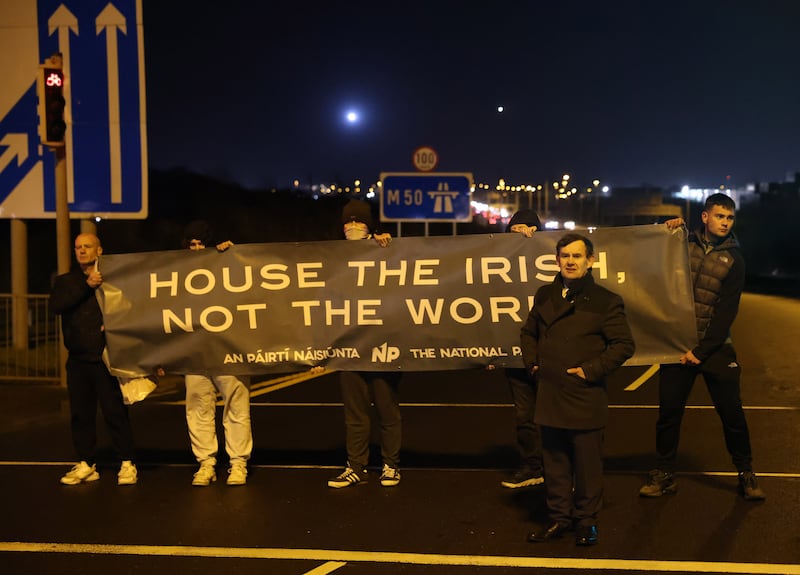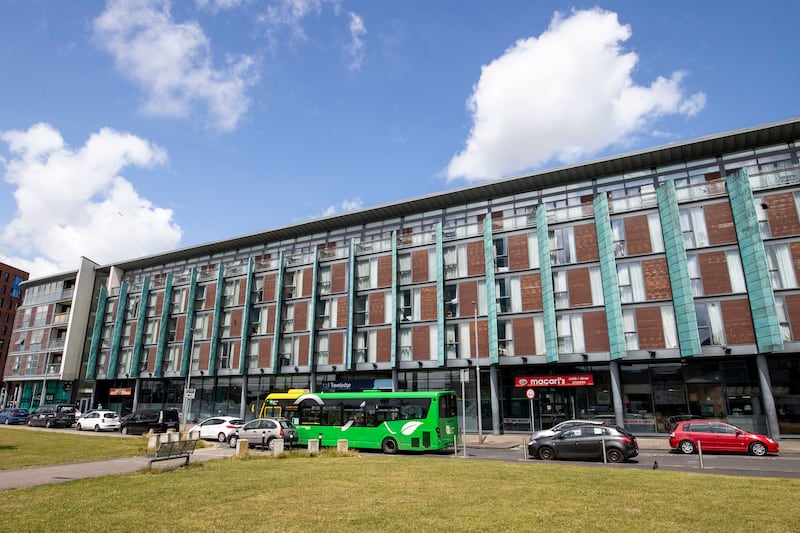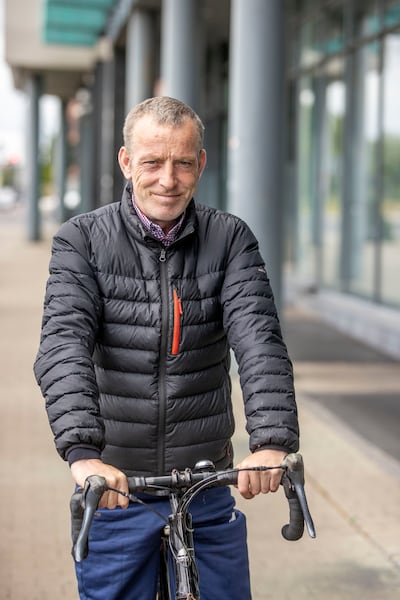Six months on from ugly anti-immigration protests in Ballymun, the north Dublin suburb is calm.
The Travelodge hotel on Shangan Road was the focus for crowds of up to 150 people gathering nightly in early January, blocking traffic and chanting “Get them out”, “Close the borders” and “Enough is enough”. Today it is peaceful.
Though it had already been used to house asylum seekers for a number of months, the protests outside did not start until after Christmas, when videos began circulating online of a bus of asylum seekers arriving at the nearby Sentinel Tower apartments on December 23rd.
Some locals were already annoyed the Travelodge, which had previously been used as a family-hub for homeless families, had been emptied and repurposed for asylum seekers. They raised concerns about the arrival of more asylum seekers – most of whom were single men. Their concerns were quickly exploited.
READ MORE
Videos and messages were shared, going viral from about December 27th, and members of the National Party arrived, as they had a few weeks previously in East Wall, distributing leaflets with such messages as: “House the Irish, not the world.”
Tension and divisions grew rapidly as rumours spread.
Protests began at the Travelodge in the new year. Among protesters were teenagers on bikes, scooters, and horse-drawn traps – or sulkies, blocking M50 traffic, causing considerable rush-hour disruption.
Many were young women with buggies and young children, voicing fears about “unvetted” and “military-aged” men and anger about not having “a say” about who was being “forced” into “our community”. Terms such as “overpopulation” were used in an area already desperately under-resourced with housing, schools and health services.

Gardaí maintained a high-visibility presence throughout, as residents inside the centre, especially those with children, feared possible violence. Garda Commissioner Drew Harris warned that far-right activists were using anti-asylum seeker protests for their own “sinister” agenda.
This week the Travelodge remains home to almost 200 asylum seekers, coming and going without apparent notice. On the footpath outside the mainly Irish locals are happy to talk to The Irish Times.
All that midwinter fear and dread – felt by politicians, the gardaí and media as some of Dublin’s poorest residents screamed rage at newly arrived asylum seekers – feels almost misplaced now.
But Robert Murphy, who own and runs a Supervalu supermarket across the road, offers a warning. “It could all happen again tomorrow ... We still haven’t got into the nitty-gritty of the ongoing poverty and trauma” that played a role in bringing people to those protests, he says.
The area is the subject of one of the largest and most costly regeneration plans in the State, involving in the demolition of 36 blocks of flats that had been built in the 1960s and rehousing of 18,000 residents between 1999 and 2006. After 40 years of estate mismanagement, endemic poverty, and heroin and Aids crises, Ballymun remains among the most marginalised communities in the State.
The Pobal deprivation index, based on 2016 census data, classifies the small areas around the Travelodge as “very disadvantaged”, with up to 85 per cent of households in local authority rented homes. Just 3.8 per cent of adults have a third-level education. Unemployment is at 50 per cent, and 73 per cent of households with children are headed by a lone parent.
Murphy, who is also on the board of the Ballymun Family Resource Centre, says poverty has worsened in the past decade. “I would say there are families here poorer now than they ever were, especially in the last 12 months,” he says.

Local housing and community activist Dean Scurry says “the norm in this community is daily struggle”.
“We have had 50 years of neglect, shit and trauma. We are knee-deep in a crack cocaine epidemic. Insert on top of that: ‘Take out your homeless and put in immigrants’ – it’s not a big move to ‘Get them out’,” he says.
People in Ballymun “know the power is not here ... decisions about Ballymun are not made here”, adds Scurry.
He points to figures from the Department of Equality showing, as of June 11th, of the 7,772 asylum seekers accommodated in Dublin, just six are in Dublin 4 – with 287 in Dublin 11, including 260 in Ballymun.
“If you are in poverty, and don’t have any power, the one bit you do have is to protect your own family. As soon as you see that coming under threat, you want to do the gorilla-chest and shout, ‘No, no, no’. And fear is like paraffin when you pour that on hurt and anger,” says Scurry.
Outside the Supervalu supermarket those who stop to talk are concerned about immigration, but stop short of supporting the protests. They link their struggles to immigration.
Most express deep distrust of Government and mainstream media.
A woman in her 20s, who supported the protests “as much as I could, with childcare, says: “We are absolutely overrun by military age men. They’re not documented. No one knows who they are. I wouldn’t walk around Ballymun now at night-time. It’s way too unsafe.”
A woman in her 60s, carrying a bag of groceries, says: “There’s too many coming in that we can’t cope. Everything is going up and you are just meant to accept it but you are not getting a rise in your social welfare to keep up with all this.
“I am only after getting a few items and it came to €30. I pay rent out of my money and bills, so I am left with €150, and €50 goes into the ESB every week. It’s like a slot machine. That leaves me with €100 for other bills and the shopping. I am stressed up with the whole situation. And then you’re just meant to accept all these coming in too.”
Her sister gets information from Facebook. “She’s well educated. She’s on this fella’s page and he gives speeches. He sees what’s going on, what Government is covering up.”
Asked if she watches or listens to the news, or reads newspapers, she looks askance. “No. It’s all blatant lies. We never get the truth,” she says.

Michael McDonagh stops on his bike to chat. He believes there are “a lot of illegal immigrants coming in and they’re not vetted. They’re not checked.”
Does he believe wealthy, white people coming to Ireland should be “vetted”? He thinks for a moment.
“To be honest with you, I suppose in a way you wouldn’t. I don’t want to be contradicting myself. There’s a lot of stories being put on [social] media, a lot of things about African men at schools taking pictures of girls ... I wouldn’t be frightened of them. It’s mothers and kids I’m frightened for.
“I’ve seen the reports on social media but I haven’t seen things happening my own self.”
A Ballymun Garda spokesman said there had been no reports of men taking photos, or any increase in antisocial behaviour since the housing of asylum seekers there.
It’s easier to say, ‘Those working class people look like they’re angry and a bit racist. Let’s not talk about anything else’
— Activist Dean Scurry
Mary Adams and Yvonne Farrell are friends, living in Ballymun for more than 40 years. “I have nothing against them,” says Farrell. “Years ago the Irish went to England. But what I can’t understand is why they are all young men, military age, between 18 and 30. Where are their wives and children?”
“There is a fear” and worry “they are kind of taking over a bit”, says Ms Adams. “They say they are going to house all these people. What about our own? My daughter is 21 years on the housing list.”
Farrell doubts promises about increased resources, to accompany asylum seekers in an area, would be kept. When Ballymun was being regenerated, “we were to have a bowling alley, a new shopping centre, a picture house. We were to have a Metro North. Where did all the money go? People are fed up ... I don’t really blame these people that’s coming in. It’s the Government I blame.”

The protests ended almost as suddenly as they started, says Paul Browne, manager of the Ballymun Family Resource Centre.
“We saw a lot of people, including people we support here in the centre, were swept up in the moment on the protests. We decided the worst we can do is go head-on, up against the protests. That would only make people feel defensive,” he says.
The centre, along with myriad other agencies in the community including schools, sports and voluntary agencies, and activists such as Scurry, developed the Ballymun For All group almost immediately.
“We decided not to engage with the protest but with the people, one to one, where they were at, ask them, ‘Why are you doing it? What’s it all about?’” says Browne. “So we did try consciously as a community to have conversations with people, and not alienate.”
Once people had space to think about the narrative and what was happening at the protests, they stopped going, he says.

How the far right spreads misinformation and enflames anger at refugee protests
This patient, on-the-ground work has been “far more effective” in “inoculating Ballymun against hate” than a series of loud counter-protests could be, says Niamh McDonald, co-ordinator of the Hope and Courage Collective, which supports communities to counter racism and other forms of hate.
Other things have helped too: messaging from trusted locals such as footballer Philly McMahon, and ensuring asylum seekers themselves are involved in local activities such as Tidy Towns, the Sanctuary Runners, weekend park runs in Poppintree Park, and in the local Muck‘n’Magic community garden.
“Space was created to enable most of those involved to stop and think about the possible ramifications of their actions, with people they trusted,” she says.
Communities such as Ballymun cannot both absorb a disproportionate share of vulnerable asylum seekers and tackle the trauma caused by intergenerational poverty, which can easily be exploited and channelled into hatred, warn community activists.
“It’s not Ballymun’s responsibility,” says Browne. “It’s everyone’s. It’s easy to stand in Donnybrook and say: ‘It’s over there and nothing to do with us’. But it’s the ones saying it’s nothing to do with us that are causing most of the harm by ignoring it.”
Echoing those comments, Scurry says the narrative “that brown, male immigrants are a threat” is easy to confirm online “if you want”. The difficult conversation is about who profits from it.
“Is it Twitter? Is it Instagram? Is it our own Government? Is it landowners hoarding land and profiting from homelessness?” he says.
“It’s easier to say, ‘Those working class people look like they’re angry and a bit racist. Let’s not talk about anything else.’ If we’re serious about tackling racism, we have to be serious about tackling those systems that blame working-class communities and profit from it.”


















